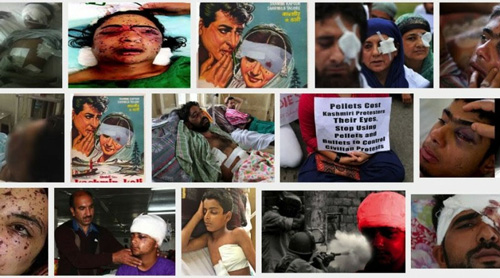On 28 August 2020, Indian forces in
Srinagar opened fire with “pellet
guns” on a peaceful religious procession. More than forty people were wounded while several were blinded. As usual, Pakistan protested vehemently. As usual, Indians responded on Twitter with triumphalism and aggression — if you don’t want to get shot, they said, don’t come out on the streets. And as usual, the world watched in silence.
It was not always so. India first started using pellet-firing shotguns against the Kashmiris in 2010 but the matter only hit international prominence in 2016 when protests following the death of Burhan Wani resulted in thousands of injuries, the blinding of hundreds and the deaths of over 70 people. The Guardian, for example, published a story asking if Kashmir represented “the world’s first mass blinding.” Even Indians were rocked by a viral series of pictures showing the distorted faces of celebrities.
The storm of international condemnation resulted in India scaling back the use of pellet-firing shotguns but not abandoning the weapons. In August 2019, when protests erupted against the revocation of Article 370, the Kashmiris were again dispersed with shotguns.
Subsequently, shotgun usage subsided but that was simply because there was an unprecedented months-long lockdown in Kashmir in which people were confined to their houses. But as recent events show, India has not given up on shotguns. They remain India’s weapon of choice to deal with the Kashmiris.
One of the many tragedies of Kashmir is that it often gets subsumed into a larger narrative about the “unfinished business of Partition.” This narrative imposes a geostrategic lens on the issue and leads to a reductive analysis about whether Kashmir belongs to either India or Pakistan, a debate which India then further muddies by trying to paint all Kashmiri opposition as Islamic terrorists, a debate which the rest of the world has long since learned to tune out. greater kashmir pellet victimKashmiris are not just symbols of injustice: they are real people living real lives in terrible pain.
They also have rights under international law, rights which are being consistently violated. Irrespective of how the territorial issue of Kashmir is eventually resolved, there is a human aspect to Kashmir which needs to be confronted now. This is not just a dry legal dispute to be debated in textbooks and seminars: India’s ongoing use of shotguns is a war crime.
Indian sources and by extension, many international sources — normally do not use the word “shotgun” to describe the weapons used by Indian forces in Kashmir. Instead, they use the term “pellet gun.” This is a misnomer. The term “pellet gun” is associated with the type of airguns used to shoot balloons at village fairs; that is, guns which fire individual pellets and must be reloaded after every shot. However, the guns used by Indian forces bear no resemblance to such weapons. Instead, Indian forces use standard 12 gauge pump-action shotguns, each of which can be loaded with up to four shotgun shells.
Admittedly, each shotgun shell is in turn loaded with up to 600 pellets. But that, by itself, is no excuse to refer to a deadly weapon as if it was a child’s toy. As Orwell advised many years ago, it is generally better to use plain words. To quote a group of English parliamentarians,”[The phrase ‘shotgun’ may better convey the violence which these weapons embody. These shots can mutilate and blind and have had an impact on hundreds of individuals caught in the crossfire.”
So far as international law is concerned, the position is very simple: there is no legal regime which permits a state to routinely disperse crowds of civilians by firing shotguns at them. This is true whether it is assumed that India has illegally occupied and annexed Kashmir (as per Pakistan), that Kashmir is “disputed territory” (as per the UN Security Council, the UNGA and the OIC); or whether one assumes that Kashmir is an integral part of India (as per the Government of India).
If we start with India’s contention that it exercises undisputed sovereignty over Kashmir, it follows that the Kashmiris are entitled to the full range of human rights afforded to them under international law (including the right not to be shot at random with shotguns). Of course, India may argue that (a) international law is only applicable to the extent enacted into domestic law; and (b) India’s independent judiciary has decided that the use of shotguns for crowd control does not violate Indian law. However, there are certain human rights obligations which cannot be ignored by any state, irrespective of domestic laws and domestic judges. Article 6(1) of the International Convention on Civil and Political Rights (ICCPR) is one such norm and states as follows:
Kashmiri doctors and paramedics, their eyes covered by patches, protest at a hospital in India-held Kashmirs Srinagara area in hopes of evoking the plight of victims of pellet guns fired by Indian security forces to disperse crowds. “Every human being has the inherent right to life. This right shall be protected by law. No one shall be arbitrarily deprived of his life.”
The key word here is “arbitrary.” And in this context, it is important to examine the weapon itself which is being used.
The shotguns used by the Indian army are manufactured at the Ordnance factory in Ishapore. Till date, Indian authorities have refused to divulge information about them on national security grounds. However, reports suggest that the guns are crude copies of the American Mossberg 500 series which were originally used in World War 1 for close-quarter combat.










